Related Research Articles

Hatshepsut was the fifth Pharaoh of the Eighteenth Dynasty of Egypt, ruling from c. 1478 or 1479 BC until her death in 1458 BC.
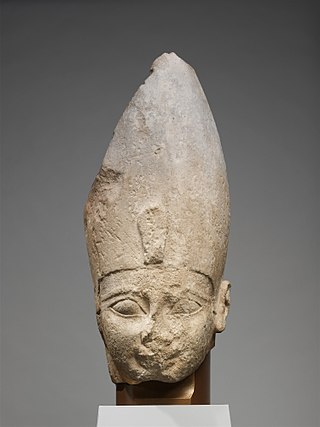
Ahmose I was a pharaoh and founder of the Eighteenth Dynasty of Egypt, classified as the first dynasty of the New Kingdom of Egypt, the era in which ancient Egypt achieved the peak of its power. He was a member of the Theban royal house, the son of pharaoh Seqenenre Tao and nephew of the last pharaoh of the Seventeenth dynasty, Kamose. During the reign of his father or grandfather, Thebes rebelled against the Hyksos, the rulers of Lower Egypt. When he was seven years old, his father was killed, and he was about ten when his brother died of unknown causes after reigning only three years. Ahmose I assumed the throne after the death of his brother, and upon coronation became known as nb-pḥtj-rꜥ "The Lord of Strength is Ra".

Thutmose III, sometimes called Thutmose the Great, was the sixth pharaoh of the Eighteenth Dynasty. Officially, Thutmose III ruled Egypt for almost 54 years and his reign is usually dated from 28 April 1479 BC to 11 March 1425 BC, from the age of two and until his death at age fifty-six; however, during the first 22 years of his reign, he was coregent with his stepmother and aunt, Hatshepsut, who was named the pharaoh. While he was shown first on surviving monuments, both were assigned the usual royal names and insignia and neither is given any obvious seniority over the other. Thutmose served as the head of Hatshepsut's armies. During the final two years of his reign, he appointed his son and successor, Amenhotep II, as his junior co-regent. His firstborn son and heir to the throne, Amenemhat, predeceased Thutmose III.
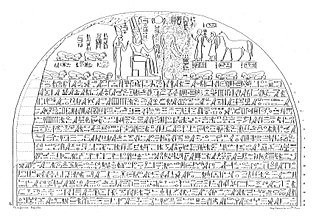
Piye was an ancient Kushite king and founder of the Twenty-fifth Dynasty of Egypt, who ruled Egypt from 744–714 BC. He ruled from the city of Napata, located deep in Nubia, modern-day Sudan.

The New Kingdom, also referred to as the Egyptian Empire, is the period in ancient Egyptian history between the sixteenth century BC and the eleventh century BC, covering the Eighteenth, Nineteenth, and Twentieth dynasties of Egypt. Radiocarbon dating places the beginning of the New Kingdom between 1570 BC and 1544 BC. The New Kingdom followed the Second Intermediate Period and was succeeded by the Third Intermediate Period. It was Egypt's most prosperous time and marked the peak of its power.
Lynda Suzanne Robinson is an American writer, author of romance and mystery novels. She is best known for her series of historical whodunnits set in Ancient Egypt during the reign of Tutankhamun and featuring Lord Meren, "the Eyes and Ears of Pharaoh". She lives in Texas with her husband and has a doctorate in anthropology from the University of Texas at Austin.
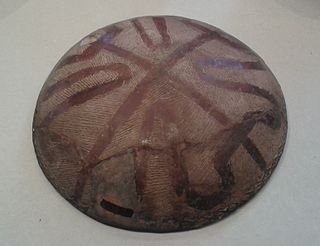
The C-Group culture is an archaeological culture found in Lower Nubia, which dates from ca. 2400 BCE to ca. 1550 BCE. It was named by George A. Reisner. With no central site and no written evidence about what these people called themselves, Reisner assigned the culture a letter. The C-Group arose after Reisner's A-Group and B-Group cultures, and around the time the Old Kingdom was ending in Ancient Egypt.
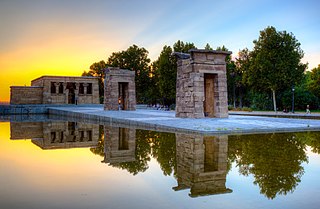
The Temple of Debod is an ancient Egyptian temple that was dismantled as part of the International Campaign to Save the Monuments of Nubia and rebuilt in the center of Madrid, Spain, in Parque de la Montaña, Madrid, a square located Calle de Irún, 21–25 Madrid.
John Maddox Roberts is an American author of science fiction, fantasy, and historical fiction including the SPQR series and Hannibal's Children.

The Tombos Stela is an ancient Egyptian rock inscription found in the area of Tombos (Nubia), dated to Year 2 of Pharaoh Thutmose I. It attests to his military campaign into Nubia around the area of the 3rd cataract of the Nile. It was discovered around 1829, on a large boulder in Tombos, Nubia on the east bank of the Nile. Thutmose is known to have expanded Egypt’s borders throughout his reign, not only in Nubia, but also by campaigns in the Syria-Palestine area. During the Middle Kingdom, pharaohs such as Mentuhotep II had already expanded into Nubia. However, scholars argue that the Tombos stela is evidence of farther expansion by Thutmose into Nubia than previous kings.
Michael Raymond Donald Ashley is a British bibliographer, author and editor of science fiction, mystery, and fantasy.
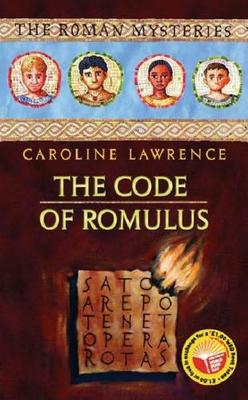
The Code of Romulus is a children's novella by Caroline Lawrence, published in 2007 to celebrate the 10th anniversary of World Book Day. It is a re-publication of the short story Bread and Circuses that appeared in the anthology The Mammoth Book of Roman Whodunits published in 2003.

Nubia is a region along the Nile river encompassing the area between the first cataract of the Nile and the confluence of the Blue and White Niles, or more strictly, Al Dabbah. It was the seat of one of the earliest civilizations of ancient Africa, the Kerma culture, which lasted from around 2500 BC until its conquest by the New Kingdom of Egypt under Pharaoh Thutmose I around 1500 BC, whose heirs ruled most of Nubia for the next 400 years. Nubia was home to several empires, most prominently the Kingdom of Kush, which conquered Egypt in the eighth century BC during the reign of Piye and ruled the country as its 25th Dynasty.

The Eighteenth Dynasty of Egypt is classified as the first dynasty of the New Kingdom of Egypt, the era in which ancient Egypt achieved the peak of its power. The Eighteenth Dynasty spanned the period from 1550/1549 to 1292 BC. This dynasty is also known as the Thutmosid Dynasty for the four pharaohs named Thutmose.
This page list topics related to ancient Egypt.
Bouchercon is an annual convention of creators and devotees of mystery and detective fiction. It is named in honour of writer, reviewer, and editor Anthony Boucher; also the inspiration for the Anthony Awards, which have been issued at the convention since 1986. This page details Bouchercon XXXIV and the 18th Anthony Awards ceremony.
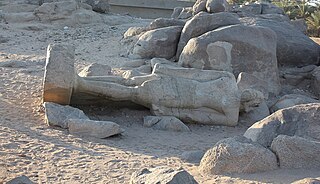
Tombos or Tumbus is an archaeological site in northern Sudan, including Tombos island and the nearby riverbank area. Tombos is located at the Third Cataract of the Nile and on the northern margin of the Dongola Reach, not far from Kerma. The occupation of Tombos, revealed by archaeological work, began in mid-18th Dynasty of Egypt and continued through the 25th Dynasty. In the New Kingdom period, a large range of pharaonic and private royal inscriptions from 18th Dynasty and elite tombs in Egyptian style indicates Tombos was an important node of Egyptian colonial control. In the New Kingdom, Tombos witnessed the blending and entanglement of Egyptian and Nubian traditions.
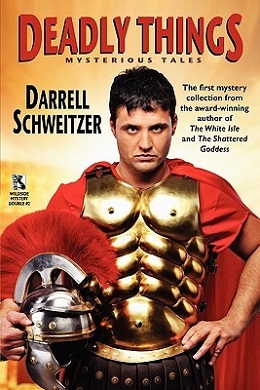
Deadly Things: A Collection of Mysterious Tales / The Judgment of the Gods and Other Verdicts of History is an omnibus of two collections of fantastic historical mystery short stories issued in dos-à-dos format; Deadly Things: A Collection of Mysterious Tales, by American writer Darrell Schweitzer, and The Judgment of the Gods and Other Verdicts of History, by Robert Reginald. It was first published as a trade paperback by Borgo Press/Wildside Press in January 2011 as the second number in its Wildside Mystery Double series. The omnibus's constituent collections were not published separately.

The Search for Ancient Egypt is a 1986 illustrated monograph on the history of the rediscovery of ancient Egypt and of Egyptology. Written by the French Egyptologist Jean Vercoutter, and published by Éditions Gallimard as the first volume in their pocket collection "Découvertes". The book was awarded a literary prize by the Fondation de France in 1987.
Myriam Seco Álvarez is a Spanish archaeologist and Egyptologist. A distinguished authority in those fields, the author of several reference books, and responsible for excavations in the Middle East and Egypt, she has launched and directed important archaeological projects, including the excavation and restoration of the mortuary temple of Pharaoh Thutmose III. The so-called "Spanish Indiana Jones", she has had a prolific professional career and a broad international presence.
References
- ↑ The Mammoth Book of Egyptian Whodunnits, 2002, p. 165
- ↑ "Archived copy" (PDF). www.mysteryscenemag.com. Archived from the original (PDF) on 26 February 2007. Retrieved 12 January 2022.
{{cite web}}: CS1 maint: archived copy as title (link)